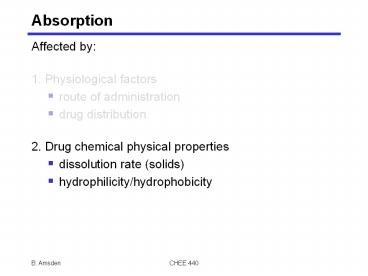Absorption - PowerPoint PPT Presentation
1 / 27
Title:
Absorption
Description:
Absorption Affected by: 1. Physiological factors route of administration drug distribution 2. Drug chemical physical properties dissolution rate (solids) – PowerPoint PPT presentation
Number of Views:104
Avg rating:3.0/5.0
Title: Absorption
1
Absorption
- Affected by
- 1. Physiological factors
- route of administration
- drug distribution
- 2. Drug chemical physical properties
- dissolution rate (solids)
- hydrophilicity/hydrophobicity
2
Pathways of Oral Absorption
- Two main mechanisms of transport across
- the gastrointestinal membrane
- Transcellular diffusion
- Paracellular diffusion
3
Transcellular Diffusion
The transcellular pathway is composed of 3
mechanisms passive diffusion, carrier-mediated
transport, endocytosis
Passive diffusion
4
Partition coefficient, Ko/w
- for absorption into cell, drug must pass through
lipid cell membrane - consider two immiscible phases (oil and water)
and a drug which is soluble in both (ex.
cyclosporine), at equilibrium.
oil
water
ideal and ideally dilute solutions
5
Clinical Significance of Ko/w
- prediction of absorption of drugs through various
tissues - absorption of acidic drugs from colon
- absorption of basic drugs from small intestine
6
Partition Coefficient and Absorption
Optimum Ko/w
7
Carrier-Mediated Transport
- Active transport
8
Drug Solubility
- Solubility the extent to which a drug dissolves
under a given set of conditions of solvent and
temperature - significance
- drugs must be in solution before they can be
absorbed - drugs of low aqueous solubility present
formulation problems - saturation concentration, Csat
- limit of solubility of a solute in a solvent at a
given T
9
Dissolution Rate
- important for tablets, capsules, suspensions
- slow dissolution rate low bioavailability
- consider a solid particle in water
stagnant water layer
Noyes-Whitney Eqn
10
Dissolution Rate
- But, surface area changes with time
- for spherical particles
- for N particles
r radius at time t ro initial radius r
density
M mass of particles k cube-root
dissolution constant
11
Factors influencing Csat
- crystal structure polymorphism, hydrates
- pH
- salt form
- common ion effect
- co-solvents
12
Process of Dissolution
13
Crystalline Solids
- Have a regular, ordered structure
- composed of identical repeating units - unit cell
- ex. cubic, rhombic, tetragonal
- Have distinct melting pts (Tf).
- Strength of bonds between atoms, molecules
determines - geometry of unit cell
- Tf,
14
Crystalline Solids
- Electrostatic, Covalent Bonds
- ex. NaCl, graphite (C4)
- strong bonds - cubic unit cell
- hi Tf, hi (eg. Tf 801C for NaCl)
- stable structure
- hard, brittle
15
Crystalline Solids
- Van der Waals, H-bonds
- ex. organic compounds
- weak bonds
- low Tf, low (e.g. Tf 238C for
caffeine) - soft materials
- metastable structures
16
Polymorphism
- molecule can crystallize into more than one
crystal structure - metastable form transforms to stable form over
time - usually nonreversible process - monotropic
polymorphism - many polymorphic forms possible
- progesterone - 2
- nicotinamide - 4
- dissolution rate changes with polymorphic form
17
Amorphism
- no crystal structure
- no distinct Tf
- supercooled liquids - subdued molecular motion
- flow under an applied pressure
- generally easier to dissolve
18
Crystal Hydrates
- solvent trapped when compound crystallizes -
solvates - solvent is water - hydrates
- no water - anhydrate
- solvent-compound interactions
- H2O further stabilizes lattice - polymorphic
solvates - H2O occupies void spaces - pseudopolymorphic
solvates
19
Crystal Hydrates
- anhydrate has higher Tf, generally dissolves
faster
20
Crystal Hydrates
- Significance
- incorporation of H2O affects bioabsorption rate
and ? bioactivity
21
pH and drug solubility
- weakly acidic drug
- pHp ? the pH below which the drug precipitates
from solution - weakly basic drug
- pHp ? the pH above which the drug precipitates
from solution
22
Drug Salt Form
- salt solubility depends on nature of counter-ion
23
Slightly Soluble Electrolytes
- ex. Al(OH)3, Ca2CO3, ZnO, drug salts
- AgCl(s) ? Ag(L) Cl-(L)
- Ksp Ag Cl- 1.25(10-10) at 25C
- Al(OH)3 ? Al3(L) 3OH-(L)
- Ksp Al3 OH-3 7.7(10-13) at 25C
- beware of common ion effect (salting-out)
24
Other solubility issues
- Cosolvents
- solvents which, when combined, increase the
solubility of a given compound - ex. phenobarbital in water has a solubility of
0.1g/100 ml, in alcohol 1 g in 10 ml, and in 20
alcohol/water 0.3 g/100 ml - Combined effect of pH and cosolvent
- adding alcohol to buffered solution of weak
electrolyte increases solubility of undissociated
form - decreases pHp for a weakly acidic drug
25
pH and Ko/w
- Dissociated portion of drug does not dissolve in
oil phase. - Partition coefficient
- Apparent partition coefficient
26
pH and Ko/w
- As pH changes, HAw changes
weak acid
weak base
27
Summary
- Absorption of drug is influenced by combination
of permeability and solubility - Implications of Low Drug Permeability
- incomplete absorption
- rapid, complete dissolution needed
- release may need to be modified
- increase exposure to an absorption window
- possible retarded release if a saturable
transport phenomenon exists - Implications of Low Drug Solubility
- poor absorption
- may need co-solvent or penetration enhancer































